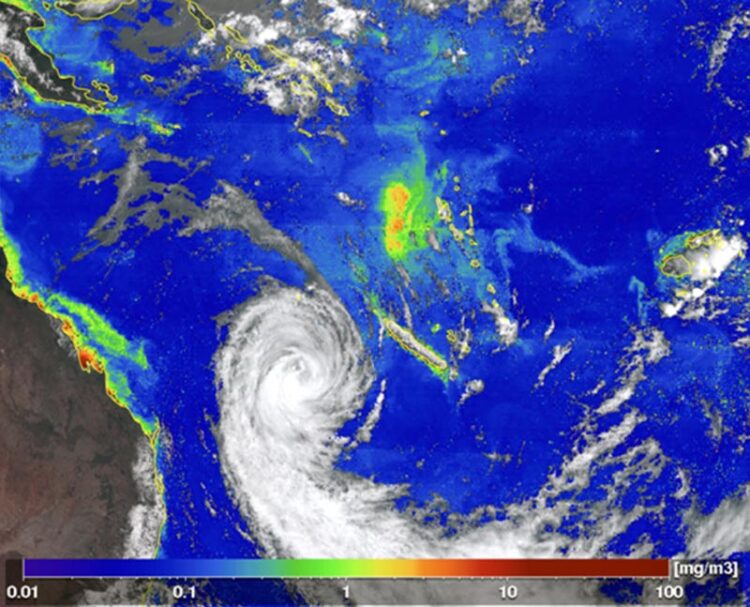Phytoplankton blooms offer insight into impacts of climate change

Research product of chlorophyll-a (produced from Himawari-8) that was used in this paper. IMAGE: P-Tree System, Japan Aerospace Exploration Agency (JAXA)
The first study into the biological response of the upper ocean in the wake of South Pacific cyclones could help predict the impact of warming ocean temperatures, New Zealand researchers believe.
Dr Pete Russell, of the University of Otago’s Department of Marine Science, and Dr Christopher Horvat, of the University of Auckland’s Department of Physics, have published a study on the oceanic biological effect of Cyclone Oma which passed near Vanuatu in 2019.
“While Oma was a relatively benign cyclone, it produced a massive phytoplankton bloom in its wake – the single most abnormal event in the history of South Pacific chlorophyll measurements,” Dr Russell says.
“Such an extreme event can produce a large amount of biomass in a part of the ocean that is typically a biological desert. We don’t yet know about the fate of this biomass, but one possibility is that it could end up on the bottom of the ocean, sequestering carbon.”
The study, just published in Geophysical Research Letters, found the phytoplankton bloom produced by Oma was exceedingly rare, occurring just once every 1500 years in the same location.
“Cyclones are one of the mechanisms that dissipate heat from the tropics. Warming oceans mean more heat to dissipate. This means more intense storms and perhaps longer storm seasons resulting in more storms.
“By examining sediment cores from the last inter-glacial period, we may get a heads up on what cyclone activity to expect with ocean temperatures 1+ degrees higher than today,” Dr Russell says.
The pair found if a storm hovers above a patch of ocean long enough, physical interactions between the cyclone winds and ocean will cause water to rise near its eye, bringing nutrient rich water to the surface which seeds a phytoplankton bloom.
Dr Horvat says these events may be biological hotspots, causing large amounts of biological material to be produced in areas typically devoid of upper-ocean life.
“These cyclones can do amazing things – other than have strong winds, they can also dramatically affect the plants and animals living in the upper ocean and change the cycling of carbon by leading to blooms.
“Along with these bloom events in the open ocean, cyclone activity results in both coastal upwelling and runoff from the land that also deliver nutrients into the photic zone, generating blooms. These blooms could be an integral part of the local marine ecosystems of our Pacific neighbours supporting higher food chains,” he says.
The researchers say they know too little about phytoplankton blooms to declare them as being good or bad, but they believe there is potential for them to support open ocean ecosystems that are nutrient limited.
“We hope to investigate this further, in particular the influence on fisheries for Pacific islands,” Dr Horvat says.
*The researchers note recent cyclones in the South Pacific were unique to Oma.
Cyclone Gabrielle moved too fast to produce a bloom due to its circular motion, however it did, through interactions with reefs in the coral sea, lead to a bloom there.
Cyclones Judy and Kevin again did not hover long enough in the same region to produce a phytoplankton bloom due to circular motion, but because both passed over larger islands there was evidence of a bloom due to run-off of nutrients from the land.
Journal: Geophysical Research Letters
DOI: 10.1029/2022GL100821
Article Title: Extreme South Pacific phytoplankton blooms induced by tropical cyclones
Article Publication Date: 28-Feb-2023
All latest news from the category: Earth Sciences
Earth Sciences (also referred to as Geosciences), which deals with basic issues surrounding our planet, plays a vital role in the area of energy and raw materials supply.
Earth Sciences comprises subjects such as geology, geography, geological informatics, paleontology, mineralogy, petrography, crystallography, geophysics, geodesy, glaciology, cartography, photogrammetry, meteorology and seismology, early-warning systems, earthquake research and polar research.
Newest articles

Silicon Carbide Innovation Alliance to drive industrial-scale semiconductor work
Known for its ability to withstand extreme environments and high voltages, silicon carbide (SiC) is a semiconducting material made up of silicon and carbon atoms arranged into crystals that is…

New SPECT/CT technique shows impressive biomarker identification
…offers increased access for prostate cancer patients. A novel SPECT/CT acquisition method can accurately detect radiopharmaceutical biodistribution in a convenient manner for prostate cancer patients, opening the door for more…

How 3D printers can give robots a soft touch
Soft skin coverings and touch sensors have emerged as a promising feature for robots that are both safer and more intuitive for human interaction, but they are expensive and difficult…




















